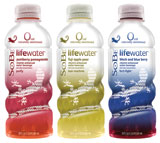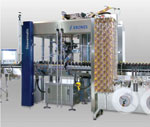
Packages are a little like Hollywood actors and actresses. They should look good in a distinctive way, be thin, be versatile and generally make a dramatic statement.
And if packages are actors, labeling machines are their dressers.
Modern labeling equipment has to handle multiple challenges. It now deals with extra-thin materials in both packages and labels. Packagers are demanding more variety than ever, in terms of both frequent changeovers and different kinds of labels on a single system. And the containers themselves are, literally, going through contortions to attract attention. Odd shapes are becoming more common because they have more shelf presence, says Dave Niemuth, director of labeling technology for Krones Inc.
“Anything like that that sits on a store shelf, next to a straight-wall container, I think history has it that the consumer is going to pick up that fancier container,” Niemuth says.

Pre-shrinking a label is a good way to insure registration on a tricky shape, such as the spiral indentation on SoBe 0-cal Lifewater.
Shrink to fit
As containers move away from straight walls, they require alternatives to conventional labeling. Shrink-sleeve labels can adhere to unique shapes in a way that’s not possible for pressure-sensitive or glued labels.“There are so many new bottle shapes coming out now that don’t really lend themselves to the flat surface that you need to do shrink-sleeve,” says Steve Winders, director of sales and technical services for Label-Aire.
Some packages demand extra-precise label orientation to complement an eccentrically shaped container.One example is the new polyethylene terephthalate (PET) bottle for SoBe 0-cal Lifewater from PepsiCo. The shrink-sleeve label features a stylized version of the trademark SoBe lizard whose body and tail wrap completely around the bottle-and align with a spiral indentation that also runs around the bottle.
To get the lizard to fit the groove, Krones furnished a system with a Leister gun, which uses hot air to affix the sleeve to the bottle before it enters a heat tunnel for final shrinking. This ensures that the label will not shift in the tunnel and throw the graphics out of register.
Variety rises
Another trend that makes demands on label equipment is the move by packagers to use a greater variety of labels. Anheuser-Busch, for instance, went to clear film labels for its Bud Light 12-ounce bottles, but stayed with paper labels for its flagship Budweiser.To achieve the flexibility needed for this kind of shifting, labeler manufacturers have developed modular systems with stations that apply different kinds of labels, but use a common carousel and infeed/outfeed components. These components sometimes are permanently attached; other times they can be literally wheeled in and out as needed.
“You can move the container for P-S or cold-glue or hot-melt stack applications, because all these different application methods require different motions of the containers through the labeler,” says Mike Scheitinger, product manager for labeling divisions for KHS USA. “Now changeovers can be happening, in general, within an hour, going from one application method to the next.”
These kinds of set-ups not only make changeovers faster, they provide maximum functionality in limited space, Niemuth says.
“It allows flexibility,” he says. “Instead of having a dedicated pressure-sensitive labeler and a dedicated cold-glue labeler, where real estate is so important-it’s so expensive-they want to cut down on conveyors and they want to cut down on real estate in plants. You now have a labeler that can do both of those.”
In very high-speed applications, extra stations can serve another purpose: redundancy. When two stations for the same label type are available on a system, operators can simply switch back and forth between them as labels run out or if a problem emerges. Niemuth cited the example of an Anheuser-Busch system that has six pressure-sensitive stations: two for the label at the front of the bottle, two for the back label and two for the neck label.

Shrink-sleeve labeling is a way to provide good coverage of irregularly shaped containers.
Slimming down
Another trend that labelers have to address is materials becoming thinner-both the containers and the labels themselves.Containers, especially plastic ones, are getting thinner for two reasons: greater environmental appeal and cost-cutting. But that can make it harder to get the label on reliably.
“Some of the problems associated with too thin a sidewall is that you get a belly in the product,” says Chuck Wepler, vice president and general manager for Quadrel Labeling Systems. “It’s like trying to label a football.”
Putting a label on an extra-thin container often requires a change in application method, Scheitinger says.
“It’s like putting wallpaper on,” he says. “You start in the middle if you have very difficult wallpaper. Some other ones, you can start at the top and brush it down. With labeling, it’s the same way. You apply the label at the center of container and make the container turn differently.”
Thinner label materials also pose a challenge. With some pressure-sensitive labels, both the actual label and the backing liner are getting thinner, making them harder for some machines to handle. The problem is that the “die strike” that cuts the label’s outline against the liner may go too deep, weakening the liner and making the web liable to snap on the labeler.
“There’s going to be a certain point where [we] have to say, ‘Wait a second, guys, this material is getting to be so thin, you pull one of these pieces off and it’s like a piece of tissue paper. It’s going to be very difficult for us to maintain our high quality of label efficiency,’” Niemuth says.
The answer is collaboration between label suppliers and labeling equipment suppliers. “They always are very good about coming to Krones and our competitors and saying, ‘Hey, I don’t want to go to Anheuser-Busch and cause their lines to go down,’” Niemuth says.
The innovative shapes and sizes of today’s containers can make labeling a challenge. But modern labeling equipment, properly specified, can help packagers handle these containers and use their advantages to the fullest.
For more information
The following companies helped with the research of this article:KHS USA
262-797-7200;www.khs.com/us
Krones Inc.
414-409-4000;www.kronesusa.com
Label-Aire Inc.
800-959-2425;www.label-aire.com
Quadrel Labeling Systems
800-321-8509;www.quadrel.com
